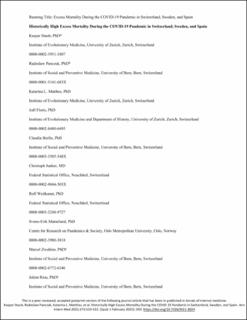| dc.description.abstract | Background: Excess mortality quantifies the overall mortality impact of a pandemic. Mortality data have been accessible for many countries in recent decades, but few continuous data have been available for longer periods.
Objective: To assess the historical dimension of the COVID-19 pandemic in 2020 for 3 countries with reliable death count data over an uninterrupted span of more than 100 years.
Design: Observational study.
Setting: Switzerland, Sweden, and Spain, which were militarily neutral and not involved in combat during either world war and have not been affected by significant changes in their territory since the end of the 19th century.
Participants: Complete populations of these 3 countries.
Measurements: Continuous series of recorded deaths (from all causes) by month from the earliest available year (1877 for Switzerland, 1851 for Sweden, and 1908 for Spain) were jointly modeled with annual age group–specific death and total population counts using negative binomial and multinomial models, which accounted for temporal trends and seasonal variability of prepandemic years. The aim was to estimate the expected number of deaths in a pandemic year for a nonpandemic scenario and the difference in observed and expected deaths aggregated over the year.
Results: In 2020, the number of excess deaths recorded per 100 000 persons was 100 (95% credible interval [CrI], 60 to 135) for Switzerland, 75 (CrI, 40 to 105) for Sweden, and 155 (CrI, 110 to 195) for Spain. In 1918, excess mortality was 6 to 7 times higher. In all 3 countries, the highest peaks in monthly excess mortality in 2020 were among the highest monthly excess mortality since 1918, higher than most monthly excess mortality caused by seasonal influenza or heat waves.
Limitation: Historical vital statistics might be affected by minor completeness issues before the beginning of the 20th century.
Conclusion: In 2020, the COVID-19 pandemic led to the second-largest infection-related mortality disaster in Switzerland, Sweden, and Spain since the beginning of the 20th century. | en_US |
